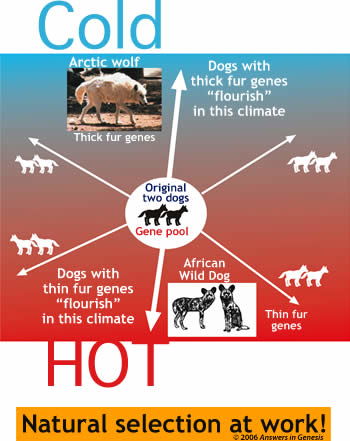Natural Selection=Evolution?
Before You Go—Overview of Biblical History
on March 1, 2013
You may encounter many examples of “natural selection in action” while visiting the museum. Many evolutionists claim that natural selection is the process that drives fish-to-philosopher evolution. Amoeba-to-architect evolution requires that, over time, living things must add more information to their DNA as they gain new features, abilities, or structures. However, natural selection actually works in the opposite direction of what molecules-to-man evolution requires. It selects from already-existing genetic information, and cannot generate new genetic information.
God created the original animal kinds with much diversity in their DNA, so that as they reproduced and filled the earth, their descendants were able to adapt to many different environments. Scientists have observed this—animals reproduce “after their kind” (dogs have puppies, cats have kittens, geese have goslings, kangaroos have joeys, etc.). The genetic makeup of some members of a kind is more suitable to certain environments. Natural selection is the process by which animals die out when they don’t have the genetic makeup that allows them to survive in their environment.
Those animals that survive reproduce more animals like themselves. For example, many animals that live in drier regions of the world are able to gain most of the water they need from the plants they eat. Animals without this ability would have a harder time trying to survive in that region, and would eventually die out. Natural selection is not a process that changes molecules into men over millions of years. Natural selection may bring about a new species of animal, but it cannot generate a new kind of animal.
For more information, visit www.answersingenesis.org/go/selection.
Museum Guide
Are you exasperated by all the hype about "millions of years" in secular museums? The Museum Guide will help!
Browse Kids BookRecommended Resources
- © 2024 Answers in Genesis
- Privacy Policy
- Contact
- About




